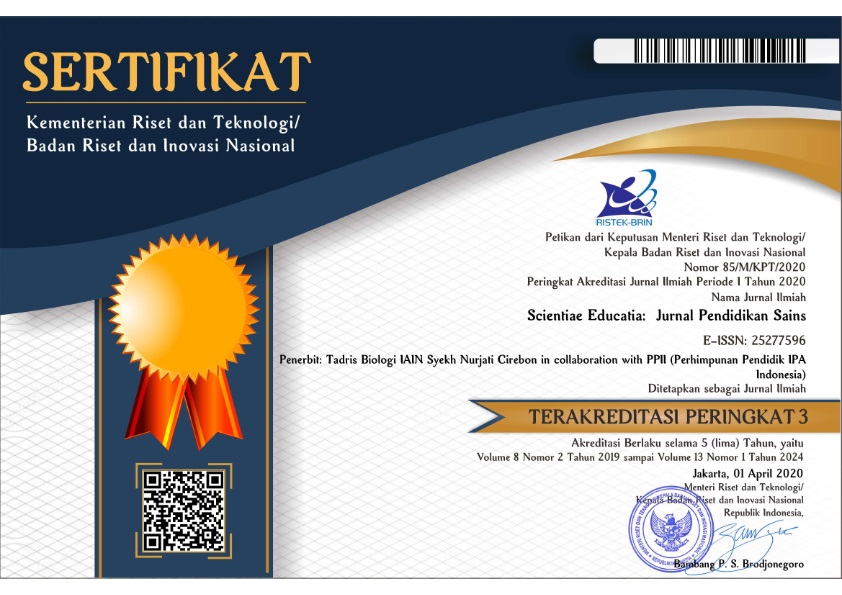The Benefit of Purple Aruk Rice (Siangu) in Lowering Body Mass Index (BMI) and Body Fat Percentage
(1) STKIP MUHAMMADIYAH BANGKA BELITUNG
(2) STKIP MUHAMMADIYAH BANGKA BELITUNG
(*) Corresponding Author
Abstract
Aruk rice is an iconic rice from Province of Bangka Belitung which is made from cassava while purple aruk rice (PAR)e is made from sweet potato (Ipomea batatas). Ipomea batatas is a high nutritional food that possesses several medicinal value including anti-cancer, antidiabetic, and anti-inflammatory activities. This research aimed to assest the organoleptic features of PAR and analyze the effect of PAR consumption in lowering the BMI and bofódy fat percentage. The design of this research was randomized crossover design with quasi experimental research within subjects single-factor two-level design. This experiment consist of three phases, phase 1 (plain rice consumption), wash out phase, and phase 3 (PAR consumption). The only different between two phases was the source of the carbohydrate. The data of decreasing BMI and body fat percentage betweern plain rice diet and purple aruk rice was analyzed by using paired t test. Organoleptic assessment showed that the aroma of PAR is dislikeable but the natural purple colour is likeable. The decreasing of BMI and body fat percentage was found higher in phase 2 (2,05±0,10) than phase 1 (0,4±0,14), p=0,002. The decreasing of body fat percentage was also found higher in phase 2 or purple aruk rice diet (2,55±0,25) compared to phase 1 plain rice diet (0,5±0,20), p=0,003. Consumption of aruk purple rice lower BMI and body fat percentage more effective than consumption of plain rice.
Â
Keywords
Full Text:
PDFReferences
Beglinger C, Degen L, Matzinger D, D’Amato M, Drewe J. (2001). Loxiglumide a CCK-A receptor antagonist, stimulates calorie intake and hunger feelings in humans. American Journal of Regulatory, Integrative and Comparative Physiology. 280, 149-154. Available Online: https://www.ncbi.nlm.nih.gov/pubmed/11247838.
Bodinham CL, Frost GS, Robertson MD. Acute ingestion of resistant starch reduces food intake in health adults. (2010). British Journal of Nutrition. 103, 917-922. Available Online: https://www.ncbi.nlm.nih.gov/pubmed/19857367
Cambie RC, Ferguson LR. (2003). Potential functional foods in traditional Maori dier. Mutat Res. 524, 109-117. Available Online: https://www.cambridge.org/core/journals/public-health-nutrition/article.
Carvalho IS, Cavaco T, Carvalho LM, Duque P. (2010). Effect of photoperiod on flavonoid pathway activity in Ipomea batatas L. (Ipomea batatas L. (Lam.) leaves. Food Chem. 118, 384-390. DOI: 10.1016/j.foodchem.2009.05.005
Dini I, Tenore GC, Dini A. (2009). Saponins in Ipomea batatas L. Tubers, isolation, characterization, quantification and antioxidant propeties. Food Chem. 113, 411-419. Available Online: http://www.sciepub.com/reference/74120
Handayani NA, Cahyono H, Arum W, Sumantri I, Purwanto, Soetrisnanto D. (2017). Study characteristics of analog rice made from purple sweet potato (Ipomea batatasi) flour and starch. Jurnal Aplikasi Teknologi Pangan. 6(1), 12-19. Available Online: http://jatp.ift.or.id/index.php/jatp/article/view/210
Helen OT, Olusola AE, Eghosa I, Bond AU, Ezekiel AD. (2013). Ipomea batatas L. extract reduces food intake, fasting glucose levels, and body weight. Eurpean Journal of Medicinal Plant. 3(4), 530-539. Available Online: https://pdfs.semanticscholar.org/b9ea/ 756cd2eec866651bbe9545b6add7f6e721ce.pdf
Huang DJ, Lin CD, Chen HJ, Lin YH. (2004). Antioxidant and anti-proliferative activities of sweet potato (Ipomea batatas (L.) Lam “Tainong 57â€) constituents. Bot Bull Acad Sin. 45, 179-186. Available Online: https://ejournal.sinica.edu.tw/bbas/content/2004/3/Bot453-01.html
Hylla S, Gostner A, Dusel G. (1998). Effect of resistant starch on the colon in healthy volunteers, possible implications for cancer prevention. American Journal of Clinical Nutrition. 67, 136-142. Available Online: https://www.ncbi.nlm.nih.gov/pubmed/9440388
Ishida H, Suzuno H, Sugiyama N, Innami S, Tadokoyo T,
Maekawa A. (2000). Nutritive evaluation on chemical components of leaves, stalks, and stems of sweet potato (Ipomea batatas Poir). Food Chem. 68, 359-367. DOI: 10.1016/S0308-8146(99)00206-X
Islam S, Yoshimoto M, Ishiguro KK, Yamakawa O. (2003). Bioacive compounds in Ipomea batatas leaves. ISHS Acta Hortic. 2, 693-699. Available Online: https://www.liebertpub.com/doi/full/10.1089/jmf.2013.2818.
Ju R, Zheng S, Luo H, Wang C, Duan L, Sheng Y, Zhao C, et al. (2017). Purple sweet potato attenuate weight gain in high fat diet induced obese mice. Journal of Food Science. 82, 787-793. DOI: 10.1111/1750-3841.13617
Kang SY, Sung SH, Park JH, Kim YC. (1998). Hepatoprotective activity of scopoletin, a constituent of Solanum lyratum. Arch Pharm Res. 21, 718-722. Available Online: https://onlinelibrary.wiley.com/doi/full/10.1002/ddr.20297
Lenz TL, Hamilton WR. (2004). Supplemental product used for weight loss. Journal of American Pharmaceutical Association. 44, 59-68. Available Online: https://www.ncbi.nlm.nih.gov/pubmed/14965155
Lim J. (2011). Hedonic scaling, A review of method and theory. Food Quality and Preference. 22, 733-747. Available Online: https://www.sciencedirect.com/science/ article/pii/S0950329311000954
Liu XL, Zhang L, Fu XL, Chen K, Qian BC. (2001). Effect of scopoletin on PC3 cell proliferation and apoptosis. Acta Pharmacol Sin. 22:929-933. Available Online: https://www.ncbi.nlm.nih.gov/pubmed/11749777
Ludvik B, Neuffer B, Pacini G. (2004). Efficacy of Ipomea batatas (caiapo) on diebetes control in type diabetic subjects treated with diet. Diabetes care 27(2), 436-440. Available Online: https://www.ncbi.nlm.nih.gov/pubmed/14747225
Ludvik B, Hanefeld M, Pacini G. (2008). Improved metabolic control by Ipomea batatas (Caiapo) is associated with increased adiponectin and decreased fibrinogen levels in type 2 diabetes subjects. Diabetes Obes Metab. 10 (7), 586-592. Available Online: https://www.ncbi.nlm.nih.gov/pubmed/17645559.
Meira M, Pereira da Silva E, David JM, David JP. (2012). Review of the genus Ipomea, traditional uses, chemistry and biological activities. Rev Bras Farmacogn. 22, 682-713. Available Online: http://www.scielo.br/pdf/rbfar/v22n3/aop01912.pdf
Monharaj R & Sivasankar S. (2014). Sweet potato (Ipomea batatas [L] Lam) – A valuable medicinal food, A review. Journal of Medicinal Food. 17(7), 733-741. Available Online: https://doi.org/10.1089/jmf.2013.2818.
Must A, Spadano J, Coakley EH, Field AE, Colditz G, Dietz WH. (1999). The disease burden associated with overweight and obesity. JAMA. 282, 1523-1529. Available Online: https://www.ncbi.nlm.nih.gov/pubmed/10546691
Nelson DL, Cox MM. 2008. Lehninger Principle of Biochemistry 4th Edition. New York, WH Freeman and Company.
Okudaira R, Kyanbu H, Ichiba T, Toyokawa T. (2005). Ipomea extracts with disaccharidase-inhibiting activities. Jpn Kokai Tokkyo Koho JP. 5, 213-221.
Oliveira EJ, Romero MA, Silva MS, Silva BA, Medeiros IA. (2001). Intracellular calcium mobilization as a target for spasmolytic action of scopoletin. Plasma Med. 67, 605-608. Available Online: https://www.ncbi.nlm.nih.gov/pubmed/11582535
Polakof S, Diaz-Rubio ME, Dardevet D, Martin JF, Pujos-Guillot E, Scalbert A. Sebedio JL, et al. (2013). Resistant starch intake partly restores metabolic and inflammatory alterations in the liver of high-fat-diet-fed rats. Journal of Nutritional Biochemistry. 24, 1920-1930. Available Online: https://doi.org/10.1016/j.jnutbio.2013.05.008
Riskesdas. (2013). Riset Kesehatan Dasar. Jakarta, Badan Penelitian dan Pengembangan Kesehatan Kemenkes RI. Available Online: http://www.depkes.go.id/resources/download/ general/Hasil%20Riskesdas%202013.pdf
Rumbaoa RG, Cornago DF, Geronimo IM. (2009). Phenolic content and antioxidant capacity of Philippine Ipomea batatas L (Ipomea batatas L.) varieties. Food Chem. 113, 1133-1138. Available Online: http://philjournalsci.dost.gov.ph/pdf/pjs_pdf/vol140no2/pdfs /Philippine_yam_tubers_phenolic_content.pdf
Shaw CY, Chen CH, Hsu CC, Chen CC, Tsai YC. (2003). Antioxidant properties of scopoletin isolated from Sinomonium acutum. Phytother Res. 17, 823-825. Available Online: https://onlinelibrary.wiley.com/doi/pdf/10.1002/ptr.1170
Sumardika IW, Jawi IM. (2012). Water extract of sweet potato leaf improved lipid profile and blood SOD content of rats with high cholesterol diet. Medicina. 43 (2), 67-70.
Nutrient Data Laboratory. United States Department pf Agriculture. Accessed 16 May, 2018. Available at http://www.nutrition-and-you.com/sweet_potato.html.
[WHO]. (2000). The Asia-Pacific perspective, redefining obesity. International association for the study of obesity.
Zhang Y, Niu FX. Sun J, Xu F, Yue RX. (2015). Purple sweet potato (Ipomea batatas L.) color alleviates high-fat-diet-induced obesity in SD rat by mediating leptin’s effect and attenuating oxidative stress. Food Science and Biotechnology. 24 (4), 1523-1532. Available Online: https://link.springer.com/article/10.1007/s10068-015-0196-7
DOI: 10.24235/sc.educatia.v7i1.1885
Article Metrics
Abstract view : 805 timesPDF - 305 times
Refbacks
- There are currently no refbacks.
Scientiae Educatia: Jurnal Pendidikan Sains indexed by:

This work is licensed under a Creative Commons Attribution 4.0 International License.
Stat Counter (Link)



1.png)












